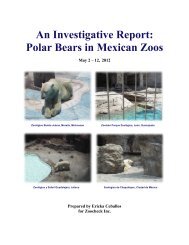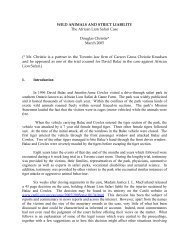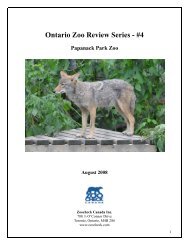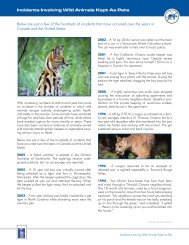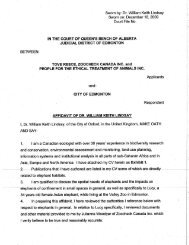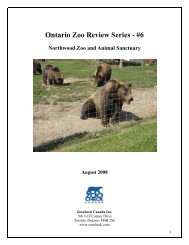STATUS OF BEAR WELFARE
STATUS OF BEAR WELFARE
STATUS OF BEAR WELFARE
Create successful ePaper yourself
Turn your PDF publications into a flip-book with our unique Google optimized e-Paper software.
Status of Bear Welfare in Cherokee, North Carolina<br />
Bear Species Discussed in This Report<br />
This report focuses on the needs of bear species found in Cherokee’s zoos, specifically American<br />
black bears, Asiatic black bears, grizzly bears, and likely Syrian brown bears. According to the<br />
AZA’s Bear Taxon Advisory Group:<br />
• American black bears (Ursus americanus) are found in 32 U.S. states, all provinces and<br />
territories of Canada with the exception of Prince Edward Island, and northern Mexico. They<br />
prefer forested areas and choose habitats that keep them away from contact with brown<br />
bears, a much larger competitor species. 1<br />
• Asiatic black bears (Ursus thibetanus) are native to Southern Asia and parts of Russia and<br />
prefer heavily forested areas, particularly in hills, mountains, and tropical forests below alpine<br />
elevations. 2<br />
• Grizzly bears (Ursus arctos horribilis) and Syrian brown bears (Ursus arctos syriacus) are<br />
sub-species of brown bears. Grizzly bears are found in western Canada, Alaska, Wyoming,<br />
Montana, Idaho, and Washington. Syrian brown bears are native to the Middle East. Brown<br />
bears choose habitats including forests, tundra, and lower alpine mountain regions. 3<br />
What Bears Expect<br />
Every modern-day species uniquely evolved over millennia to be perfectly adapted to a very<br />
specific environment. Like a human, every bear is born with a set of genetic expectations to live a<br />
certain way. Bears of the same species share certain genetic expectations. Thus all American<br />
black bears expect to live in the black bear habitat, expressing behavior that is normal to a black<br />
bear, and all grizzly bears expect to live in the grizzly bear habitat, expressing behavior that is<br />
normal to grizzly bears. No bear of any species ever expects to live in an environment as alien,<br />
hostile, and austere as a cement pit or is genetically equipped to do so successfully.<br />
Individual bears differ from each other and have their own personal history of experiences from<br />
which they learn lessons. The environment in which a bear lives also helps determine his or her<br />
responses. Genetic programming, personal history, and current circumstances make up the<br />
bear’s personality and shape his or her ability to cope with adverse conditions.<br />
Experiences in a bear’s formative years are critical to the development of his or her personality. A<br />
bear who is taken away from his or her mother, raised by humans, and then relegated to a<br />
concrete pit experiences circumstances far removed from those he or she was born to expect and<br />
can suffer severe mental, physical, and emotional disturbances as a result.<br />
Behavior-Based Bear Husbandry<br />
Wild bears need large tracts of undisturbed, nourishing land in order to survive. In captivity, a<br />
bear needs a large, natural, wooded enclosure—a minimum of one acre for every two to three<br />
adults—including a pool that is a minimum of 900 square feet in area and at least 4 feet deep.<br />
The daily and seasonal routines of black bears and brown bears are similar, so the basic<br />
husbandry routine can be similar as well. Black bears and brown bears are highly vegetarian, yet<br />
captive facilities often make the mistake of feeding them commercially prepared dog food, which<br />
AN INVESTIGATIVE REPORT <strong>OF</strong> CHIEF SAUNOOKE <strong>BEAR</strong> PARK, CHEROKEE <strong>BEAR</strong> ZOO, AND SANTA’S LAND | 8







